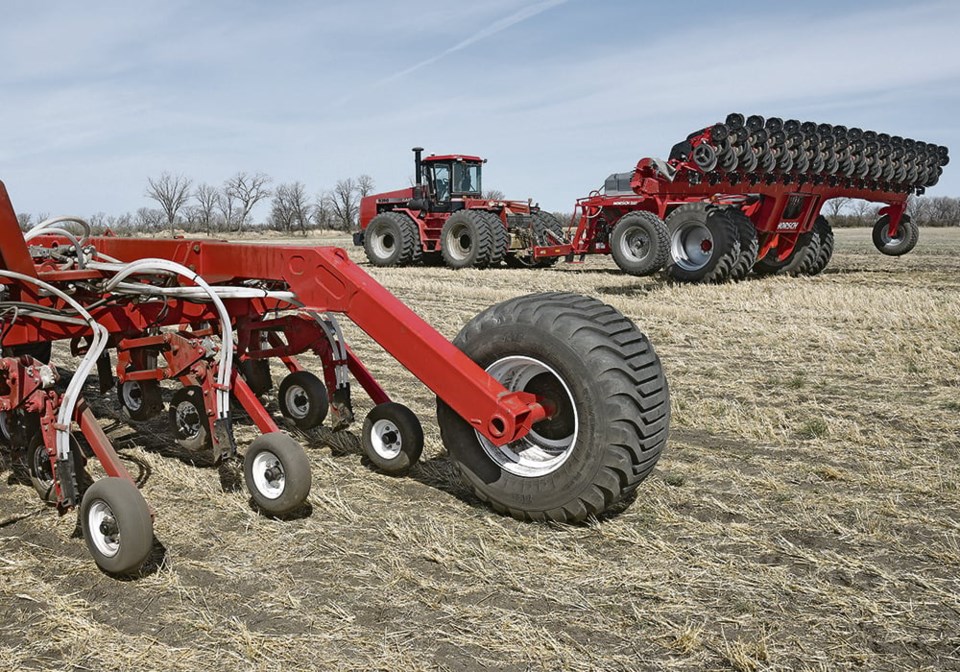BALCARRES, Sask. — Precision planters may offer yield benefits over air drills, particularly when used for narrower row spacing, according to research done in southern Alberta.
Mike Gretzinger, research co-ordinator at Farming Smarter, said several trials have shown that planters on 12-inch row spacing compared more favourably than air drills on crops such as canola, pulses and durum.
He told the Indian Head Agricultural Research Foundation’s crop management seminar that results of the most recent studies were recently accepted for publication.
However, the findings from a four-year study comparing seeding methods for canola were published last year.
That study showed yields were higher when the narrow-row precision planter was used, especially under irrigation or high precipitation. There were statistically significant differences in seven out of 12 site-years and in five of those the yields were higher when the planter was used.
“The seed yield for (the) air drill was higher than narrow-row precision planter at two site-years that received limited precipitation, while five site-years did not show a statistically significant difference between them,” said the study’s conclusion as published in the Canadian Journal of Plant Science.
The study also recommended against wide-row planters for canola.
Gretzinger said more farmers are considering row planters because they’re using them for other crops such as corn and want the value from them. Irrigation in southern Alberta has led to many cropping options, including higher value crops such as seed canola.
“There’s where a lot of this push and application of planters is coming from,” he said.
There is also a move to lower seeding rates, and a smaller plant density, while maintaining yield through agronomic practices. Gretzinger said planters could play a role in that.
“Talking to some of the farmers in our area I think they’re getting away with really, really low seeding rates,” and densities of one or two plants per sq, foot in some cases.
He likened this to “playing a dangerous game” but also said seed costs are a huge factor when growing canola.
The study used typical seeding rates of 20, 40, 60, 80 and then 160 seeds per sq. metre. The air drill was set to a 9.5-inch spacing, and the planter was used at 12-inch and 20-inch spacings. Gretzinger said planters for corn are typically set to 30-inch rows and really aren’t designed to be narrow but can be altered. Most come at 15-inch spacings now, he said.
He said the air drill plots yielded the best at 60 and 80 seeds, while the planter was at the 40 and 60 seeds rate.
The wide rows looked great in the plot, but he said farmers will leave a lot of potential yield on the table if they go that route. Even at a seeding rate of 160 per sq. metre, the rows didn’t fill in to create the canopy canola growers need.
The narrow-row planter also bested the other trials in emergence, at 1.2 to 1.5 times higher.
Planters place seeds uniformly throughout the row, compared to air drills that place seed somewhat randomly as they fall out of the tube.
The uniformity can reduce inter-plant and intra-row competition.
Previous work found canola yield can be 32 percent higher with spatially uniform stands.
While yields are higher under irrigation, the planter bested the air drill in three out of eight site-years at the dryland research sites. However, the rainfall at those sites was higher than the long-term average.
Where the air drill yield was higher, the study suggests that the more random pattern from the drill might allow the plants to access moisture between the rows.
Irrigated, planter-seeded canola yielded 10 percent higher than the drill, while wider rows resulted in a yield hit, Gretzinger said.
“That’s where the logistics and the farmer’s own operation become really important,” he said.
If they leave planters set wider because that’s what they are using for other crops, they won’t get the benefits, he said.
Farming Smarter and a local Hutterite colony did plant a field-scale trial, but it was hailed out and will have to be repeated.
Durum studies show results similar to canola. Gretzinger said durum is a stable crop for most growers in the region, but it hasn’t seen the yield gains that canola has in the last few decades.
The study, done under irrigation, found a yield boost from the planter of about five bushels per acre. Using a plant growth regulator and fungicide added another three to five bushels, while maxing out fertility added another three.
Planters used on pulses during a four-year study improved the proportion and uniformity of emergence, while the yield was similar or higher. Gretzinger said precision planting reduced the optimum seeding rate proportionately.



